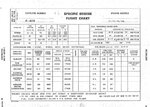Mike Williams
Senior Airman
- 572
- Oct 19, 2006
It was, yes, although the DH props were of American origin - their 'Hydromatic' and counterweight props had appeared on bombers before fitting to fighters, but these were licence built Ham Std units. Rotol was the exception in Britain, but had limited application initially. The Rotol two position prop was first fitted to Spitfires with 54 Sqn in November/December 1939. This was initially limited to 54 Sqn however and the two position DH props were introduced in the Spring of 1940 - these were bracketed counter weight props. The DH and Rotol C/S props were fitted round about the same time as each other, from June/July 1940.
Not quite I think:
"A new type of "Spitfire" fitted with a "Rotol" constant speed airscrew was collected..." - No. 19 Squadron Operations Record Book, 1 November 1939
"The Squadron commenced to re-equip with Rotol Spitfires..." - No. 54 Squadron Operations Record Book, 10 December 1939
"Aircraft of 54 Squadron were fitted with the Rotol constant speed airscrew on which we had been doing trials when the fighting started." - Alan Deere, Nice Lives, page 55
Spitfire N.3171. Merlin III - Rotol Constant Speed Airscrew. Comparitive Perfromance Trials. Aeroplane and Armament Experimental Establishment. 19th March 1940.
Rotol Airscrews for Spitfire, HQ Fighter Command, 16 June 1940
"The aeroplane may be fitted with one of the following airscrew controls" (a) de Havilland two position (b) de Havilland constant speed, or (c) Rotol (35 deg. ) constant speed." - AP 1565A, Spitfire I Aeroplane, June 1940
Hurricane L.2026. (Merlin III) (Rotol Constant Speed Airscrew) Comparitive Perfromance Trials, Aeroplane and Armament Experimental Establishment 12th June 1940.
Spitfire Conversion of 2 Pitch De Havilland Airscrews to Constant Speed, HQ Fighter Command, 17 June 1940
Spitfire I fitted with De Havilland Constant Speed Airscrew, 22 June 1940
No. 92 Squadron Operations Record Book, 25 June 1940
609 Squadron Operations Record Book, 26 June 1940
No. 611 Squadron Operations Record Book, 28 June 1940
No. 74 Squadron Operations Record Book, 28 June 1940
Flight, May 23, 1940: The Latest Rotol Airscrew
"Rotol constant-speed airscrew" - W/C Ian Gleed D.F.C., Arise to Conquer, (Random House, New York 1942) pp. 62-63.
"A new Hurricane was delivered to the Squadron, equipped with a constant speed airscrew..." - No. 1 Squadron Operations Record Book, 18 April 1940
I was flying a new aeroplane with a Rotol constant-speed prop..." - Paul Richey DFC, Fighter Pilot (Redwood Press, Wiltshire 1990) p 93.
"Huricane R3310 with Rotol Airscrew..." - No. 151 Squadron Operations Record Book, 13 April 1940
"The squadron can now put up 12 Rotol Hurricanes if required." - No. 151 Squadron Operations Record Book, 15 May 1940
Hugh Halliday, No. 242 Squadron, The Canadian Years, (Canada's Wings, Ontario, 1981). p.78.
Wing Commander Tom Neil, DFC, AFC, AE, Gun Button to 'Fire', (William Kimber, London 1987), pg 48.

